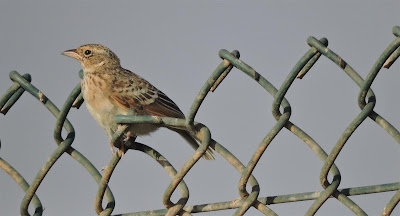male wattled starling
I decided to pay my first call to Sawnout farm since I returned to Oman this autumn. Sawnout farm is one of the closet sites to my home here but there is no access. Indeed you have to walk round the perimeter looking in. It is worth it as it is probably the largest farm in Oman and attracts many birds.
I was walking along the western fence and paid particular attention to the piles of organic fertiliser which are mid way up the western side and only about 15-25 metres inside. There are normally plenty of birds feeding off the top.
second male wattled starling
I was actually looking for ortolan bunting which is still a target species in Oman and I looked very carefully for the odd bird out.
three species in the earth
The large majority of birds there were Eurasian collared dove. Others included crested lark and a few yellow wagtail.
However four birds had distinctive yellow heads which were easily picked out among the earthy browns.
All four were male wattled starling in breeding plumage complete with black wattle. I have no idea why there were no females. Its possible I just didn't pick them up.
Wattled starling is an uncommon visitor from east Africa but males in breeding plumage are rarer still. I understand that Sawnout farm is the best bet to see them when they come but sightings in recent years have declined every where in Oman.
When I walk up the west side, I often come across birds on the perimeter fence itself as well as inside. Wednesday was not different.
African silverbill
African silverbill is flocking at the moment. I see very many or not at all.
Ruppells weaver
singing bush lark
The fence is one of the easiest places to get close to singing bush lark.
young grey-headed kingfisher
Grey-headed kingfisher is a lot less usual on the fence but this young bird was happy there.
young namaqua dove
Namaqua dove is nowhere near as common in Oman as in Saudi Arabia but near cultivation it is increasing. I saw eight including young ones. That was my highest number in the country.
three Namaqua dove
I caught a graceful prinia climbing up the wall sideways that supports the fence. I don't know why it was doing that.
graceful prinia sideways to a wall
Little green bee-eater were present in the bushes just outside the farm.
little green bee-eater
Other notable birds were a Bonelli's eagle which flew over without stopping in my part of the farm, a flock of eight white stork which were right in the middle of the farm and barely visible from the fence and a large flock of glossy ibis. The latter bird often commutes between the farm and near-by East Khawr (Khawr Dahariz).
I am now many regular short calls to the Khawr looking for any changes. I went on both Wednesday and Thursday morning before work.
The khawrs levels are very low this year as the El Nino affected the Indian ocean monsoon and reduced rainfall. On a positive note this could mean a different avifauna this year.
white winged black tern
A large number of white winged black tern have arrived. In winter plumage I have trouble identifying some terns particularly on the sand bars of the khawrs as marsh terns, common tern and sea-loving terns can all be present.
Thanks are due to colleagues on BirdForum for this identification. White-winged black tern has longer legs and a short bill than common tern which I had considered as another option.
ruff and white winged black tern
Of course a few terns are still in partial summer plumage. These are much easier to identify.
moulting white winged black tern
Two Eurasian spoonbill have also arrived.
Eurasian spoonbill
While midweek birding is necessarily local, I am keeping to my policy of making a long desert trip every Friday. I will blog about the latest next.
















No comments:
Post a Comment